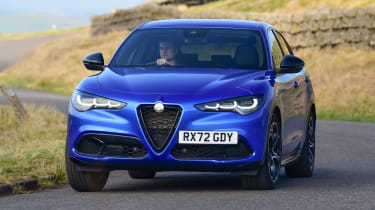Alfa Romeo Stelvio – ride and handling
The Stelvio feels pointier and lighter on its feet than most SUVs, but partly at the expense of comfort
The Stelvio's underpinnings are fairly sophisticated with double-wishbones up front and a multi-link setup at the rear. This is (unsurprisingly) much the same as the Giulia, but the Stelvio rides 140mm higher and therefore battles a higher centre of gravity. Even so, the Stelvio is as much as 185kg lighter than the four-cylinder Porsche Macan, with the 2-litre petrol tipping the scales at 1660kg.
Despite Alfa’s efforts at controlling body movements, it’s the steering you notice first. What it lacks in the kind of wriggling tactility we love from a steering system (not something delivered by any SUV, but the kind that a Porsche Macan gets closer to than most), it gains in a Ferrari-style rate of response and precision. You’ll want to keep the Stelvio in Dynamic mode to really get the best from the steering, as it reduces the assistance (though the rack still remains light, aiding the feeling of agility) and makes the off-centre response feel a little more natural.
Our test cars weren’t specified adaptive dampers, and there's a directness to the ride on gnarly UK roads. It's certainly not uncomfortable, but combined with the fast steering rack, there's a tension about the Stelvio, a tautness that robs it of the plush, relaxed feel offered by the now-discontinued Jaguar F-Pace. The dampers do have enough breadth to take the edge off the harshest impacts and the cabin is well insulated, but those stepping out of a less overtly sporting rival might find the Stelvio's character more wearing.
The trade-off is that the Alfa controls its mass well and invites you to dig into its abilities more often than other SUVs. Do so and it's satisfying to flow along at a brisk pace, and the Stelvio feels more compact than you might expect. A big hot hatch it certainly isn't, but it's easy to judge the extremes of the car and position it accurately. Beyond this point, the Stelvio isn't quite as involving as the direct steering and chassis tuning might suggest; even when fitted with a limited-slip rear diff, it's the front axle that relinquishes grip first, and there's little sense of adjustability. The slightly fluffy powertrain response is partly to blame for this, robbing you of precise throttle control unless the engine is on song.
The Stelvio is a capable SUV and does a good job of containing its mass and managing its high-riding stature, but don’t go expecting the entertaining dynamics of its less compromised Giulia Veloce relative.



